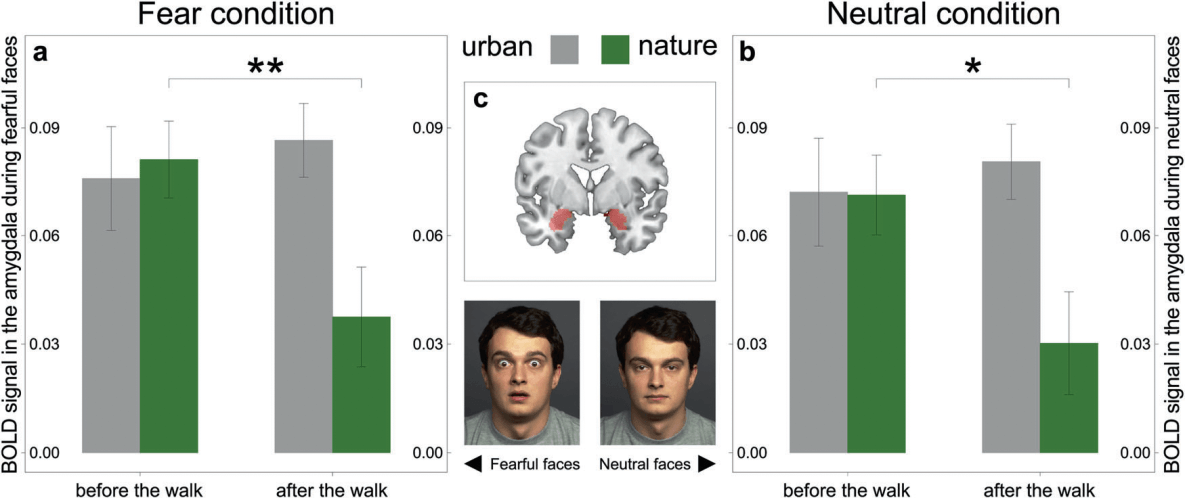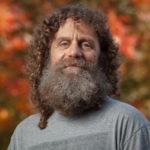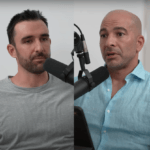To me, very few things are quite as relaxing and restorative as time spent in nature, and I know I’m not alone in that feeling. Numerous studies have reported that exposure to nature is associated with reductions in self-reported feelings of stress as well as in physiological stress metrics (e.g., blood pressure, salivary cortisol), though the underlying mechanisms contributing to the effect are poorly understood. A recent study published in Molecular Psychiatry sought to address that question – a task, it seems, which is no walk in the park.
About the Study
In the study by authors Sudimac, Sale, & Kühn, 63 participants were randomly assigned to take a 60-min walk either through busy city streets (urban group) or through a large, forested park (nature group), both located within the city of Berlin. Both before and after the walk, investigators monitored brain activity by functional magnetic resonance imaging (fMRI) to observe how natural vs. urban environments impacted activation of stress-related brain regions – in particular, the amygdala, anterior cingulate cortex (ACC), and dorsolateral prefrontal cortex (dlPFC). During both pre- and post-walk brain scans, subjects performed a Fearful Faces Task (FFT), in which they were shown images of faces with either fearful or neutral expressions, as well as various tasks known to create social stress, such as the Montreal Imaging Stress Task (MIST), in which participants were asked to solve mental arithmetic problems under time constraints. The authors selected these tasks in order to heighten participant stress, as they hypothesized that the calming effects of nature would be most apparent in a stressed state.
Their results showed no changes in neural activity in the amygdala, ACC, or dlPFC between pre- and post-walk scans in the urban group, but in the nature group, amygdala activity was found to decrease significantly from baseline. The decrease was observed during the MIST (p = 0.070) as well as in response to both fearful faces (p = 0.009) and neutral faces (p = 0.024) in the FFT (see figure below). No significant changes were observed in either group in ACC or dlPFC activity across any of the tasks performed.
Figure: Amygdala activity in response to fearful and neutral faces decreased relative to baseline following a walk in nature but remained unchanged following a walk in a busy city environment.
Given the reduction in amygdala response after a walk in nature – but not after a walk in an urban environment – the authors concluded that “nature is indeed able to restore individuals from stress,” and that city surroundings do not appear to have either the same or opposite effect. Further, they interpret the decrease in amygdala activity after nature exposure to indicate that this is likely a key brain region mediating acute and chronic benefits of nature on reducing reactivity to stressful stimuli and possibly preventing mental illnesses such as schizophrenia, which some studies have correlated to urbanization.
Validation vs. Truth
If the purpose of scientific research were to provide circumstantial evidence to validate our intuitions, we could stop this newsletter right here. Nature reduces stress by reducing amygdala activity: end of story; see you next week.
But of course, science is really about finding truth, and to achieve that goal, investigators must be vigilant in scrutinizing their own assumptions and seeking possible alternative explanations for results.
What variables define “nature”?
A “natural environment” can refer to many unique locales: anything from a tropical rainforest to the Arctic tundra, from colorful coral reefs to the monochrome vastness of the Sahara Desert. In this study, it was a forested park on the outskirts of a major city in northern Germany. Waving our hands to group all of these diverse environments under one umbrella ignores the important question: what are the specific qualities of “nature” that lead to stress reduction?
For nature to have a stress-reducing effect on humans, we must be capable of detecting and processing specific sensory signals or combinations of signals associated with natural environments. So what signals are key to the effects on stress? The absence of man-made noise? If so, would a sound isolation chamber have the same effect? A green and brown color palette? If so, would a snow-covered mountain fail to produce the same result? Or would painting city storefronts in green and brown make urban areas more calming?
Even if we assume the signal is simply the conscious awareness of being in nature, we run into the issue of where to draw the line. In a large urban park, must one be in the centermost area, away from city noise? Or is it sufficient to walk along the edge, with trees on one side and cars and commercial buildings on the other? Would having a backyard garden be enough? What about some plants around one’s office? The study authors seem to have assumed that all nature is equivalent and thus failed to isolate and test a specific independent variable, leaving us at a loss on how to interpret and act upon their results.
The amygdala mediates more than just stress responses
The investigators pre-selected three brain regions of interest as a readout for stress. They saw an effect in one of the three and interpreted this as evidence that this region mediates the stress-reducing effects of nature. But the logic of this interpretation rests on the assumption that the selected regions of interest function exclusively in stress-related contexts. This is not the case.
Given the authors’ findings, let’s focus on the amygdala. Although this region of the brain is indeed known to be involved in mediating responses to stress, amygdala activity is not limited to this function. The amygdala is a hub for emotional learning more broadly and responds to both positive and negative stimuli. It also has a central role in processing social information and in social decision-making – an example of a role which could easily confound the results of this study.
The urban and nature environments used in this experiment would have differed not only in the amount of surrounding wildlife but also in the number of surrounding people. While the nature group likely encountered a few other humans leisuring in the park, the urban group presumably would have been constantly exposed to human faces all around. Could it be possible, then, that the decreased amygdala activity in the nature group reflected the fact that these participants had simply had an hour away from other people and were thus less primed to react to the social tasks presented during the post-walk fMRI scans, whereas the urban group remained “warmed up” from a social standpoint? The fact that the nature group showed decreased responses to both fearful and neutral faces might support this alternative explanation.
Additional stress metrics might have bolstered the interpretation made by the authors, and indeed, although the investigators did not measure any other stress indicators during the brain scans, they did monitor participants’ heart rate and heart rate variability as physiological stress read-outs during the walks. While these metrics are far from perfect indicators of stress, it’s worth noting that no differences were observed between the urban and nature groups in these physiological markers. Again, this calls into serious question the stress interpretation of the amygdala findings.
Building a better experiment
Given the many variables which might define “natural” and “urban” environments – and, for that matter, the many variables which define different types of “stress” – I suspect multiple experiments will be needed in order to properly address the question of nature’s effects on acute and chronic stress responses. Expanding the experiment to include groups in a variety of natural environments might provide a starting point for identifying key environmental factors and qualities mediating nature’s calming effects. From there, those variables could be tested in a more controlled and isolated manner – for instance, by real-time exposure during fMRI sessions. Additionally, although no physiological markers are ideal indicators of stress, including measurements of heart rate or salivary cortisol at the time of the fMRI scans would aid in interpreting changes in neural activity.
Intuition isn’t Science
Allow me to reiterate that I agree intuitively with the authors’ hypothesis that time in nature reduces stress – this idea certainly aligns with my own subjective experience. I view my rucks in nature with no phone and minimal interaction with others as much a boost to my mental health as my physical health. But if intuition and subjective experience were adequate substitutes for rigorous experimentation, we’d all still believe the Earth was flat and disease was caused by an imbalance in the humors.
In this case, the investigators violated two crucial steps in the experimental process: isolate an independent variable of interest, and consider alternative explanations for results. These critical mistakes, which seemingly stem from invalid assumptions on the part of the authors, leave us with results which fail to provide any solid evidence for the authors’ overall hypothesis on the calming effects of nature, let alone reveal underlying mechanistic details. So although I continue to think that walking in nature probably does have benefits for reducing reactivity to stress, when it comes to this particular study… well, let’s just say we all know what happens when we assume.





